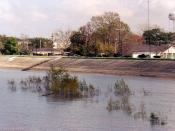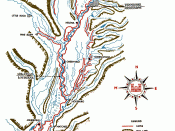Summary on the Great Rood of 1927
The spring of 1927 rained a lot, it basically never quit. The water kept getting higher everyday next to the levee, about 10 inches a day. Levee guards would have to put sandbags on top of the levee as soon as the water rose higher to try to be above the water, but it just wasn't enough. On the morning of April 21, in Bolivar County, the levee gave way.
Many people left Greenville by train before it was too flooded to use. Some just went to higher ground and waited. The Red Cross arrived and set up refugee camps for African Americans. They set up tents, kitchens and sanitary facilities and gave shots to prevent diseases. African Americans could not leave the camps and had to work on the levee. The laborers were not paid and were threatened that they would not be given food if they refused to work.
Rumors went around talking about the mistreatment but when Hoover was told about it he didn't do anything about it. Many blacks left Washington County because of this. Conditions were improving. Large pumps were brought in to drain the town and the protection levee was finished. There were still parts of the Delta in water and remained in water for months. A whole crop season was lost and many died. Many people went back to their homes and continued their lives. On July 4. 1927, a special celebratory parade was held for the fixing of the levees, The Mississippi River Flood of 1927 was one of the nation's greatest natural disasters and because of it the National Flood Control Act of 1928 was passed by the U.S. Congress.





